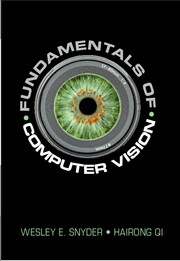Book contents
- Frontmatter
- Dedication
- Contents
- Preface
- For the Instructor
- Part I Preliminaries
- Part II Preprocessing
- 5 Kernel Operators
- 6 Noise Removal
- 7 Mathematical Morphology
- Part III Image Understanding
- Part IV The 2D Image in a 3D World
- A Support Vector Machines
- B How to Differentiate a Function Containing a Kernel Operator
- C The Image File System (IFS) Software
- Author Index
- Subject Index
- References
7 - Mathematical Morphology
from Part II - Preprocessing
Published online by Cambridge University Press: 25 October 2017
- Frontmatter
- Dedication
- Contents
- Preface
- For the Instructor
- Part I Preliminaries
- Part II Preprocessing
- 5 Kernel Operators
- 6 Noise Removal
- 7 Mathematical Morphology
- Part III Image Understanding
- Part IV The 2D Image in a 3D World
- A Support Vector Machines
- B How to Differentiate a Function Containing a Kernel Operator
- C The Image File System (IFS) Software
- Author Index
- Subject Index
- References
Summary
I think the universe is pure geometry – basically, a beautiful shape twisting around and dancing over space-time.
– Antony Garrett LisiIntroduction
In this chapter, a study of shape begins. Throughout the remainder of this book we will continue to look at shape in many different ways. Here, the topic is introduced at the pixel level, providing some simple, local operations that modify shapes, changing connectivity, and providing nonlinear ways to treat noise.
• (Section 7.2) Binary morphology changes the shape of binary objects. We define the two basic morphological operators, dilation and erosion, on the basis of which two other operators, opening and closing, can be derived. We also discuss some interesting properties of these morphological operators and their applications in noise removal and edge linking.
• (Section 7.3) We extend the discussion to grayscale morphology and define the dilation and erosion operations when the objects are not described in binary values. We progress from grayscale morphology using flat structuring elements to the use of grayscale structuring elements.
• (Section 7.4) As one of the most important applications of morphological operations, we discuss the distance transform (DT) and different ways to compute the DT.
Morphological operations may be considered as either the result of set operations, or the result of composition of functions. Both these approaches are described in this chapter, in order to provide the student with the insight to see similarities and suitability. We will find that set-theoretic ways of thinking about morphology are most appropriate for binary images, and functional notation is more convenient for grayscale images. In section 7.5, an application example of combining dilation, erosion, and distance transform for the purpose of edge linking is provided to illustrate the power of these operations.
Binary Morphology
In this section, we first introduce two basic morphological operators, dilation and erosion. We then define opening and closing, two operators that are developed based on dilation and erosion. We also discuss interesting properties of these operators and their applications in solving computer vision problems.
- Type
- Chapter
- Information
- Fundamentals of Computer Vision , pp. 119 - 146Publisher: Cambridge University PressPrint publication year: 2017

